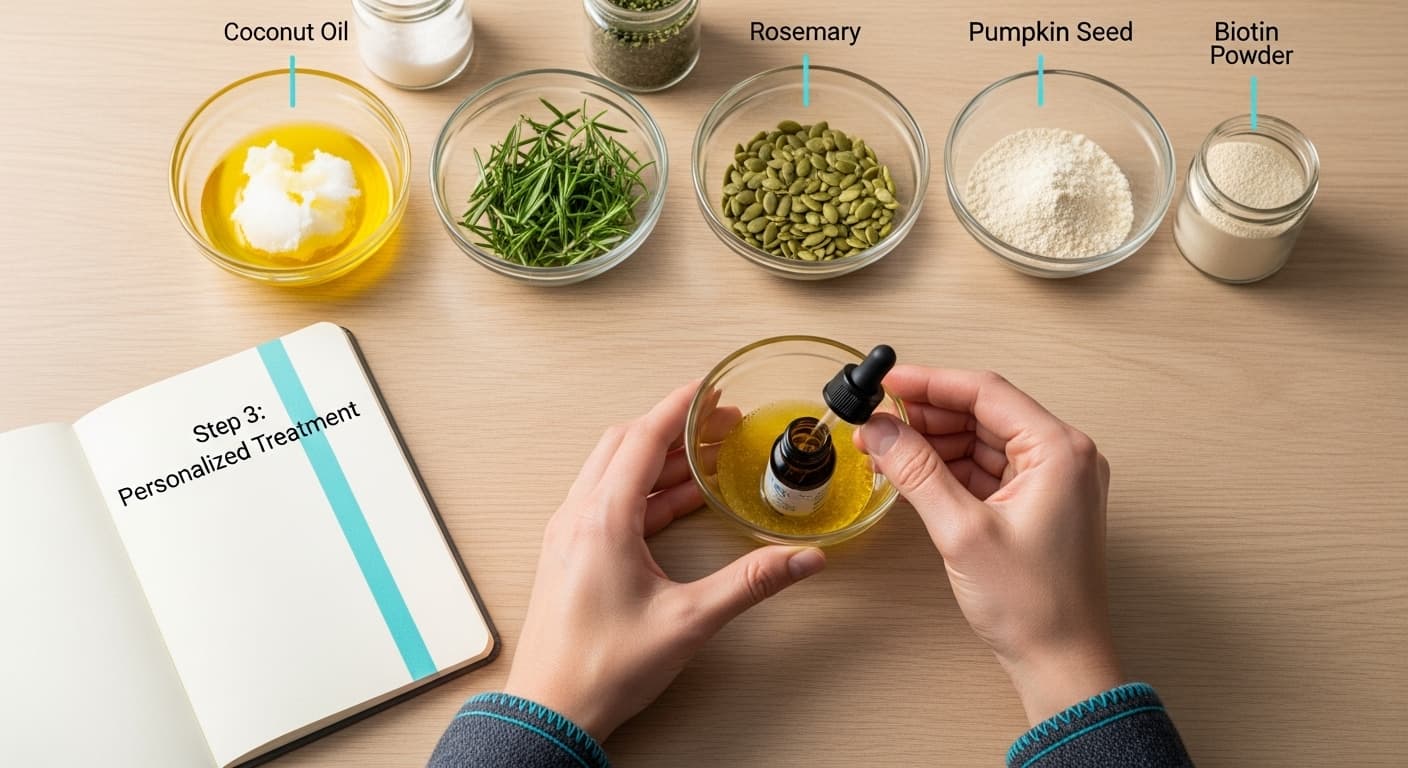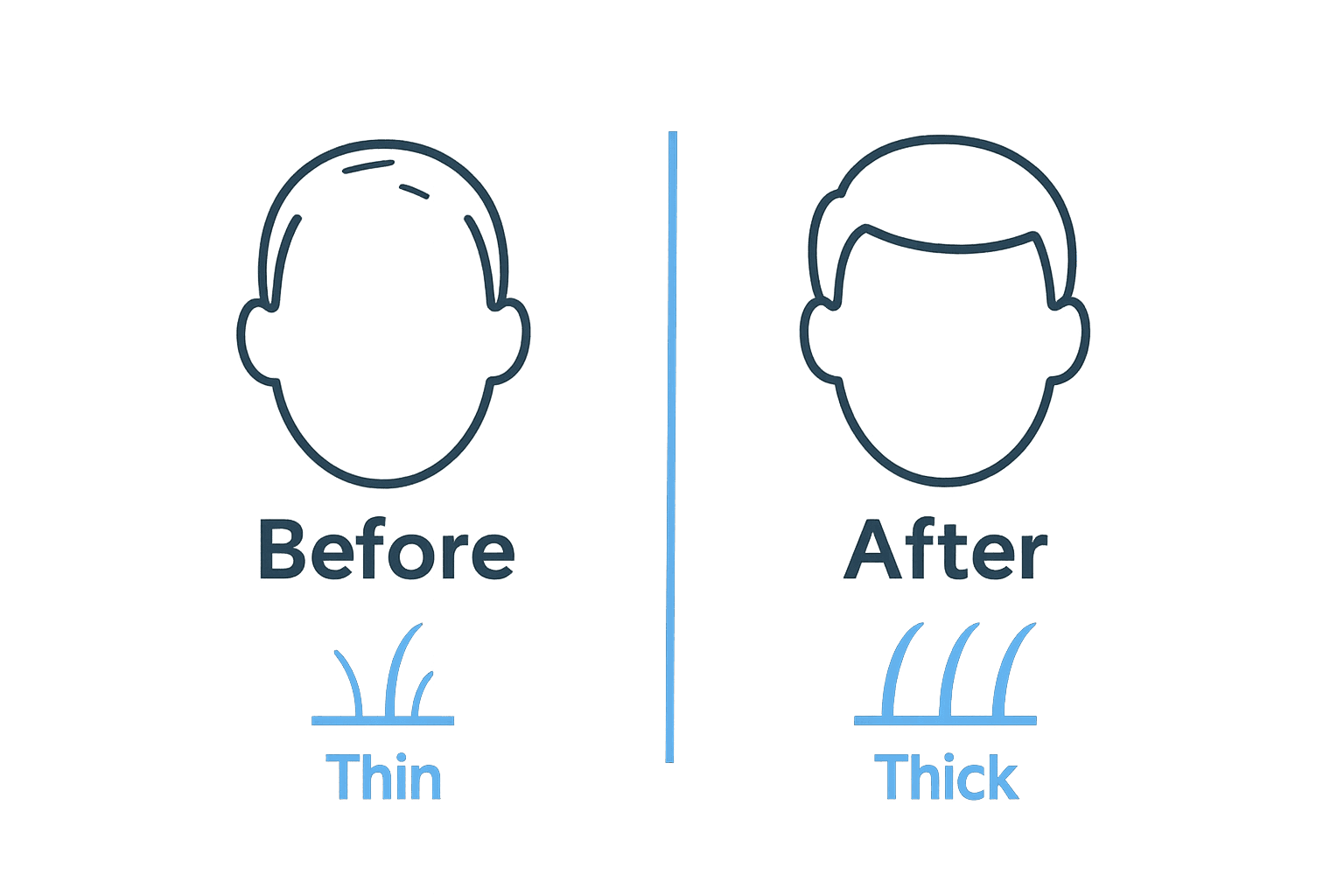Blog
Learning Materials
Natural Products for Hair Growth and Thickness: A Complete Guide
Updated: September 25, 2025

Natural hair growth tips get a lot of hype. Some tricks promise thicker hair overnight, while thousands of products flood your feed each year. Yet most people do not realize that just 50 to 100 strands lost daily is actually normal and even slight changes in your routine can trigger big shifts in hair health. The real surprise is that tracking your hair's progress and building a personalized plan can be more powerful than any one treatment or oil alone.
Table of Contents
- Step 1: Assess Your Hair Health And Growth Needs
- Step 2: Choose Effective Natural Ingredients For Growth
- Step 3: Create Your Personalized Hair Growth Treatment
- Step 4: Apply Treatments Consistently For Best Results
- Step 5: Monitor Hair Growth Progress And Adjust Routine
Quick Summary
| Key Point | Explanation |
|---|---|
| 1. Assess Your Hair Health | Conduct a thorough examination of your scalp and hair to identify specific health challenges and formulate a strategy for growth. |
| 2. Choose Effective Natural Ingredients | Select scientifically-backed botanical ingredients that stimulate hair follicles and support thickness, considering your hair type. |
| 3. Create a Personalized Treatment | Develop a hair growth treatment that includes a carrier oil and essential oils tailored to your scalp's needs and treatment plan. |
| 4. Apply Treatments Consistently | Maintain a regular application schedule and monitor your efforts, as consistency is key to achieving visible hair growth results. |
| 5. Monitor Progress and Adjust | Track hair growth metrics and scalp health, and make necessary adjustments based on your observations for optimal results. |
Step 1: Assess Your Hair Health and Growth Needs
Understanding your unique hair health profile is the critical first step in achieving natural hair growth and thickness. Every hair journey begins with a comprehensive self assessment that helps you identify your specific growth challenges and design a personalized strategy. By taking a detailed and systematic approach, you can map out the most effective path toward stronger, fuller hair.
Start by conducting a thorough visual and physical examination of your scalp and hair. Examine your hair under good lighting, looking closely at thickness, texture, and overall condition. Check for signs of potential issues like excessive shedding, breakage, dry or brittle strands, and scalp inflammation. Take high resolution photos from multiple angles to track your progress and create a baseline record.
Next, perform a series of diagnostic tests at home. Gently pull a small section of hair between your fingers to assess elasticity. Healthy hair should stretch slightly and return to its original position without breaking. If your hair snaps immediately, this indicates potential protein deficiency or damage. Conduct a shedding test by running your fingers through clean, dry hair and counting the number of strands that come out. Losing between 50 to 100 strands daily is considered normal, but anything significantly higher might signal an underlying health concern.
Complement your physical assessment with a comprehensive health review. Document your nutrition, stress levels, sleep patterns, and any recent hormonal changes. These factors significantly impact hair growth and can provide crucial insights into potential root causes of hair thinning. Learn more about personalized hair health tracking to understand how detailed monitoring can transform your hair growth journey.
To verify you have successfully completed this assessment, ensure you have:
- Detailed photos documenting current hair and scalp condition
- Written notes about hair texture, thickness, and potential issues
- A record of daily hair shedding
- Comprehensive health background relevant to hair growth
By meticulously assessing your hair health, you create a solid foundation for developing a targeted, natural approach to hair growth and thickness.
Below is a checklist table to help verify that you have successfully assessed your hair health before starting a natural hair growth routine.
| Assessment Item | Description | How to Verify |
|---|---|---|
| Scalp and Hair Photos | Take high-resolution photos of scalp and hair | Images documented from multiple angles |
| Written Notes | Document hair texture, thickness, and visible issues | Written log with detailed observations |
| Shedding Record | Track number of hairs shed daily | Tally of hair strands collected per day |
| Health Background | Record nutrition, stress, sleep, and hormonal factors | Notes on lifestyle, diet, and recent changes |
Step 2: Choose Effective Natural Ingredients for Growth
Selecting the right natural ingredients for hair growth requires a strategic approach that combines scientific understanding with targeted botanical remedies. Your goal in this step is to identify powerful, research backed ingredients that stimulate hair follicles, strengthen hair roots, and promote healthy growth without harsh chemical interventions.
The foundation of effective natural hair growth relies on understanding key botanical compounds that directly interact with your hair and scalp biology. Essential oils like rosemary and peppermint have demonstrated remarkable potential in stimulating blood circulation to the scalp, which encourages hair follicle activation. Rosemary oil, in particular, has been shown to be as effective as conventional hair growth treatments by improving cellular metabolism and reducing inflammation that can impede hair growth.
Expand your natural ingredient arsenal by incorporating protein rich and nutrient dense botanicals. Ingredients such as saw palmetto, pumpkin seed oil, and ginseng work synergistically to block DHT hormone conversion, a primary cause of hair loss. These natural compounds not only prevent further hair thinning but also support existing hair follicle strength. Discover our comprehensive guide to homemade hair growth solutions to learn more about creating personalized hair care treatments.
As you explore natural ingredients, pay close attention to your individual hair type and specific growth challenges. Some botanicals work exceptionally well for certain hair textures while being less effective for others. Create a personalized blend that addresses your unique scalp condition by combining ingredients like:
- Biotin rich ingredients like aloe vera and coconut oil
- Circulation boosting essential oils such as peppermint and rosemary
- Protein enhancing compounds like keratin and silk proteins
- Scalp healing botanicals including tea tree and lavender
To verify successful ingredient selection, ensure your chosen natural products meet three critical criteria: compatibility with your hair type, scientifically supported efficacy, and absence of potential allergenic compounds. By meticulously selecting and combining natural ingredients, you create a powerful foundation for sustainable, healthy hair growth.
The following table summarizes popular natural ingredients for hair growth, their key benefits, and suggested considerations for selecting the right option for your needs.
| Ingredient | Main Benefits | Best For | Special Consideration |
|---|---|---|---|
| Rosemary Oil | Stimulates follicles, boosts circulation | Most hair types | Patch test for sensitivity |
| Peppermint Oil | Enhances blood flow, invigorates scalp | Oily or normal scalps | Potent; dilute before use |
| Saw Palmetto | Blocks DHT, reduces hair loss | Thinning hair, early hair loss | Use in combination with oils |
| Pumpkin Seed Oil | Rich in nutrients, reduces DHT | Dry or brittle hair | Can be heavy on fine hair |
| Ginseng | Stimulates hair roots | Weak follicles, slow growth | Possible allergy in sensitive users |
| Aloe Vera | Strengthens hair, soothes scalp | Damaged or irritated scalp | Best used fresh or in pure gel form |
| Coconut Oil | Moisturizes, prevents protein loss | Dry, brittle, or thick hair | May weigh down fine hair |
Step 3: Create Your Personalized Hair Growth Treatment
Crafting a personalized hair growth treatment transforms generic approaches into a targeted strategy that addresses your unique hair challenges. This step is about translating your earlier assessments and ingredient research into a practical, actionable plan that supports robust hair growth and thickness.
Begin by selecting a base carrier oil that matches your specific scalp and hair texture. Coconut oil works wonderfully for dry, brittle hair by penetrating the hair shaft and reducing protein loss. For individuals with oily scalps, lighter options like jojoba or grapeseed oil provide nourishment without excess greasiness. Mix your chosen carrier oil with potent essential oils known for stimulating hair follicles, such as rosemary, peppermint, or lavender. The key is creating a balanced blend that supports your hair's specific needs.
Develop a consistent application routine that integrates seamlessly into your lifestyle. Most effective treatments require 15 to 20 minutes of scalp massage using your custom oil blend, performed 2 to 3 times weekly. Warm the oil slightly before application to enhance absorption and stimulate blood circulation. Massage using gentle circular motions, ensuring complete scalp coverage and minimal friction that could damage hair roots. Explore our comprehensive guide to personalized hair growth solutions to refine your approach further.
To ensure your treatment's effectiveness, incorporate dietary and lifestyle modifications that support hair growth from within. Supplement your topical treatment with protein rich foods, biotin sources, and adequate hydration. Your holistic approach should include:
- Daily intake of omega 3 fatty acids
- Consistent hydration with minimum 8 glasses of water
- Stress management techniques like meditation
- Regular sleep schedule supporting hormonal balance
- Minimal heat and chemical styling treatments
Verify your personalized treatment's success by monitoring hair texture, tracking growth rate, and observing reduced breakage over a 6 to 8 week period. Remember that consistency and patience are crucial in natural hair growth strategies. Your customized approach transforms hair care from a generic routine into a precise, scientifically informed journey toward healthier, thicker hair.

Step 4: Apply Treatments Consistently for Best Results
Consistency transforms potential into tangible hair growth results. This critical step bridges your carefully crafted treatment plan with actual physiological changes, requiring discipline, patience, and a strategic approach to application. Your commitment during this phase determines whether your natural hair growth strategy succeeds or stalls.
Timing and technique are paramount in your treatment application. Establish a precise routine that integrates seamlessly into your daily life, preferably during moments of minimal stress and maximum absorption potential. Morning treatments work best for individuals with active lifestyles, while evening applications allow longer absorption periods during sleep. Select a consistent time that ensures you can dedicate uninterrupted 15 to 20 minutes for thorough scalp massage and treatment distribution. Warm your prepared oil blend slightly to enhance penetration and stimulate blood circulation.
Use gentle circular motions, applying moderate pressure that stimulates follicles without causing scalp irritation.
Navigate potential obstacles by creating accountability mechanisms that support your hair growth journey. Many individuals struggle with maintaining consistent treatment routines due to time constraints or motivation challenges. Explore our advanced hair treatment strategies to develop a sustainable approach. Consider using digital reminders, treatment tracking apps, or placing your hair care products in visible locations that prompt regular use. Document your progress through weekly photographs and measurements, transforming your routine from a potential chore into an engaging personal transformation project.
To ensure treatment effectiveness and maintain motivation, focus on these critical implementation strategies:
- Maintain a consistent application schedule
- Track progress through regular documentation
- Adjust treatment based on observable results
- Stay hydrated and maintain a nutrient rich diet
- Protect hair during sleep with silk or satin pillowcases
Verify your treatment's success by monitoring key indicators: reduced hair breakage, improved scalp health, increased hair thickness, and accelerated growth rate. Remember that natural hair growth is a gradual process requiring patience and persistent effort. Your dedication during this phase will determine the long term success of your personalized hair growth strategy.
This table outlines key routine implementation strategies for effective natural hair growth, making it easy to check your consistency and progress.
| Action Item | Description | How to Track |
|---|---|---|
| Consistent Application | Maintain regular treatment schedule (2-3 times/week) | Set digital reminders or use an app |
| Progress Documentation | Take photos and record changes weekly | Keep a dated photo log |
| Treatment Adjustment | Adjust ingredients or frequency based on results | Monitor for changes and update plan |
| Nutrient-Rich Diet | Eat biotin, protein, omega-3 rich foods | Journal meals or use nutrition app |
| Hydration | Drink at least 8 glasses of water daily | Track with a water intake app |
| Hair Protection | Use silk/satin pillowcases during sleep | Check bedding and consistency |
Step 5: Monitor Hair Growth Progress and Adjust Routine
Monitoring your hair growth journey transforms your approach from passive treatment to active management. This crucial step empowers you to understand your body's unique response to natural hair growth strategies, enabling precise adjustments that maximize your results. Successful tracking requires a systematic, objective approach that goes beyond casual observation.
Develop a comprehensive documentation system that captures multiple dimensions of hair health. Invest in a high resolution smartphone camera or digital camera capable of capturing detailed close up images. Photograph your scalp and hair from consistent angles every two weeks under the same lighting conditions. Create a dedicated folder to chronologically organize these images, allowing you to visually track changes in hair density, thickness, and overall scalp condition. Learn more about advanced hair growth tracking techniques to refine your monitoring approach.
Quantitative tracking complements visual documentation by providing measurable metrics. Use a precise measuring tape to record hair length at the same point on your head every month. Count hair strands during your gentle washing routine to monitor shedding rates. Pay attention to subtle indicators like reduced hair breakage, improved scalp texture, and changes in hair shine and elasticity. These nuanced signals often precede more dramatic visible transformations, offering early insights into your treatment's effectiveness.
Successful monitoring requires establishing clear evaluation criteria to guide your routine adjustments:
- Track hair growth rate and compare against baseline measurements
- Note changes in hair texture and overall scalp health
- Record any modifications to diet or lifestyle
- Observe hormonal or seasonal influences on hair growth
- Document side effects or unexpected reactions
Remember that hair growth is a complex, dynamic process influenced by numerous internal and external factors. Be prepared to make incremental adjustments to your treatment plan based on your observations. Approach this journey with patience, scientific curiosity, and a commitment to understanding your body's unique response. Your systematic monitoring transforms hair growth from a passive experience into an empowering, personalized scientific exploration.

Discover Your Customized Path to Thicker, Healthier Hair
If you have been searching for a way to overcome hair thinning and slow growth, you know how overwhelming it can be to choose the right natural solutions. The article on natural products for hair growth guides you through self assessment, personalized treatments, and consistent care. However, building a truly effective routine can feel daunting without clear, scientific insights tailored to your needs.

Take the guesswork out of your hair journey. See how your unique scalp and hair profile responds to specific products and ingredients by using MyHair.ai. Upload photos of your hair and receive an AI-powered assessment, expert tracking, and customized recommendations designed just for you. Looking for more ways to monitor your progress? Discover our detailed guide on hair health tracking essentials. Ready to unlock the most effective, personalized routine for real results? Visit MyHair.ai now to start seeing thicker, fuller hair sooner.
Frequently Asked Questions
What are some effective natural ingredients for promoting hair growth?
Some effective natural ingredients for hair growth include rosemary oil, peppermint oil, saw palmetto, pumpkin seed oil, and ginseng. These ingredients stimulate hair follicles, improve circulation, and strengthen hair roots.
How often should I apply natural hair growth treatments for best results?
It is recommended to apply natural hair growth treatments 2 to 3 times a week. Consistent application, along with a scalp massage, enhances absorption and stimulates blood flow to the hair follicles.
How can I assess my hair health before starting a natural hair growth routine?
Start by examining your hair and scalp for thickness, texture, and overall condition. Conduct elastic tests for hair strength and measure daily shedding. Document your findings and consider any health factors such as nutrition and stress levels.
What dietary changes can support natural hair growth?
Incorporate protein-rich foods, sources of biotin, omega-3 fatty acids, and maintain adequate hydration. Additionally, ensuring a regular sleep schedule and managing stress can significantly impact hair health.